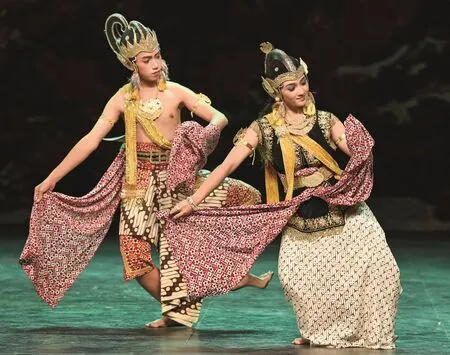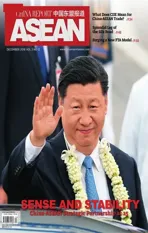A DANCE AMONG CULTURES
2018-12-25ByWangFang
By Wang Fang
“T he impressive achievements of China-ASEAN cooperation should be attributed in large part to the robust exchanges between our peoples,” remarked Chinese Premier Li Keqiang at the 21st China-ASEAN Summit, which was also held to commemorate the 15th anniversary of China-ASEAN strategic partnership. Peopleto-people exchanges have been included as one of three pillars, alongside political and security cooperation and economic cooperation, of the strategic partnership between China and ASEAN as the region looks towards the year 2030.
Over the last 15 years, China and ASEAN have constantly innovated cultural exchange mechanisms and platforms as people-to-people exchanges continue expanding rapidly. In 2005, the two sides signed the Memorandum of Understanding on Cultural Cooperation and launched the China-ASEAN Cultural Industry Forum the following year. Then in 2014, the Action Plan of China-ASEAN Cultural Cooperation was signed. That same year,the two sides utilized China-ASEAN Cultural Exchange Year to further promote people-to-people exchanges and cultural cooperation.
Huge Potential for Cultural Cooperation
The cultural industry has been on the rise globally and become a new driver for economic development. In recent years, both China and ASEAN countries have reinforced investment in cultural and creative industries, creating huge potential for cooperation in this realm.
“After 15 years of development, China-ASEAN relations have entered a mature stage of continuous improvement and upgrading,” explained Chen Dehai, secretary-general of the ASEAN-China Center, at the 13th China-ASEAN Cultural Forum.He noted that despite contrasting development levels in various cultural and creative industries,both China and ASEAN need to take measures in realms such as policy, industrial aggregation,innovation-driven development, talent cultivation and cultural exchanges to encourage and support the development of creative industries includingfilm, music and animation.
China has already joined hands with radio and television stations and cultural companies in ASEAN countries to producefilms and television programs such as New Maritime Silk Road, Children by the River, Once Upon a Time and Distance.Integrating cultural elements of both China and ASEAN countries, such productions have proved popular with viewers across the region. On February 7, 2018, a channel dedicated to excellent Chinese documentaries, “Colorful China,” went on the air in Thailand and quickly became an important platform to showcase Chinese achievements and tell Chinese stories to a foreign audience.
China has also deepened exchanges and cooperation with ASEAN countries in digitalfilm and television, animation and other areas. The two sides have successfully organized the China-ASEAN Expo Culture Exhibition, the China-ASEAN Expo Cartoon, Animation and Games Exhibition,and the Belt and Road (Nanning) Forum on Cooperative Development of Animation and Game Industries. The web version of Fishing Joy,a recreational animated game popular amongst Chinese netizens, was introduced to Thailand. In 2017, Hello Fishing, a 3D mobile game developed by a Guangxi-based game company, was released in Vietnam, marking the autonomous region’s animation and gaming industry’s entrance into the ASEAN market.

Artists from Indonesia’s Yogyakarta State University perform a scene of the Indian epic Ramayana, a play jointly presented by Chinese, Malaysian and Indonesian artists at the second China-ASEAN Drama Week in Nanning, capital of south China’s Guangxi Zhuang Autonomous Region, on October 26, 2014.
At the 13th China-ASEAN Cultural Forum, six companies signed agreements on three cooperation projects. For instance, Guangxi Millennium Legend Film and Television Media Co., Ltd. and Thai Central Chinese Television signed a contract to coproduce the animated series The Panda and the Elephant with an eye on exploring China-Thailand cultural cooperation and exchange mechanisms and expandingfilm and television co-production.
“The cultural and creative industries have great potential,” stressed Ky Anh Nguyen, director of the Sustainable Development Directorate under the ASEAN Secretariat. “We should strengthen cooperation in areas like market transfer,marketing and capital integration to create a better cultural ecosystem and future.”
Liao Xin, director of the General Office of China’s Guangxi Academy of Social Sciences, noted that China and ASEAN should tap their distinct advantages in geographical proximity, linguistic links, and cultural and ethnic identity to build a China-ASEAN cultural product trading platform,expand regional cooperation in the cultural industry by the mode of “internet+culture+finance,”and jointly explore the “blue ocean” of the cultural economy.
Education as a Focus of Cultural Exchanges and Cooperation
Over the past 15 years, a personnel training system supporting China-ASEAN cultural cooperation has taken shape. In addition to Chinese Cultural Centers, China has established over 30 Confucius Institutes in ASEAN countries.Education has become a key focus of people-topeople exchanges and cooperation between China and ASEAN.
“A decade ago, I visited China to participate in thefirst ‘Chinese Bridge’ Chinese Proficiency Competition for Foreign Secondary School Students,” recalled an international student from Singapore. “That was thefirst time I set foot in the amazing country. Soon, I decided to study in China.Today, I consider China my second home.”
The number of exchange students between China and ASEAN grows with each passing year.“Only when the people on both sides intimately understand each other’s cultural traditions can they eradicate misunderstandings and achieve joint steady development,” commented Xu Liping,director of the Research Office of Asia-Pacific Cultures under the Chinese Academy of Social Sciences.
In 2010, China and ASEAN launched the“dual-100,000 program” that aims to increase the number of exchange students between the two sides to 100,000 by 2020. China now sees ASEAN countries as an important education market.“Xiamen University has opened a campus in Malaysia, and conversely, we hope to establish close cooperation relations with Chinese universities,”said Dr. Jayles Yeoh, deputy vice chancellor of Asia Metropolitan University in Malaysia. He added that Asia Metropolitan University already offers classes in some Chinese colleges and universities and that he hopes to carry out various forms of educational cooperation with China.
According to Fan Pik Shy, an expert from the Institute of China Studies at the University of Malaysia, China and ASEAN have created wide space to carry out youth education cooperation.Shy noted that deepening mutual talent exchange is conducive to cultivating young leaders with global vision and inclusive spirit and consolidating China-ASEAN relations.
“China will set up the China-ASEAN Young Leaders Scholarship and launch the ‘Bridge of the Future’ China-ASEAN Young Leaders Training Program,” pledged Premier Li Keqiang in his speech at the 21st China-ASEAN Summit. “Over the nextfive years, we will invite 1,000 young talents from ASEAN countries to China for training to sow the seeds of friendship in the hearts of our peoples.”
So far, China and ASEAN have established exchange and cooperation mechanisms in areas such as the cultural industry, education, youth and tourism while constantly expanding cultural exchanges via platforms such as the China-ASEAN Expo Cultural Exhibition, China-ASEAN Cultural Industry Forum and China-ASEAN Arts Festival.
